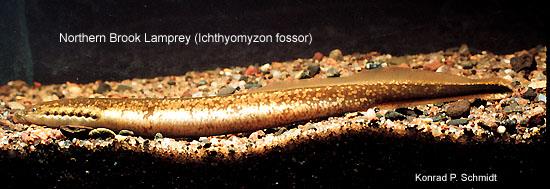Fish Iowa - Fish Species - Northern brook lamprey

Characteristics
The dorsal fin is continuous, not divided into two distinct fins. The mouth is a sucking disc, teeth are small and poorly developed. Ammocoete length range from 130 to 170mm while adults range from 115 to 170mm long.
Foods
Larval stage eats small plants, animals and bits of organic matter; adult digestive system is non-functional showing that no food is consumed from fall until spring.
Expert Tip
- No results found
Details
Adult Northern Brook Lamprey are more easily differentiated from American Brook Lamprey, but adults are less commonly collected. The Northern Brook Lamprey ammocoete may have been collected in past sampling, but misidentified as American Brook Lamprey ammocoete.
The Northern Brook Lamprey is non-parasitic, living 3-5 years as a filter feeding larvae (ammocoete) in the bottom sediments of streams before transforming into a non-feeding adult in mid-summer to late fall. The following spring the adult lamprey spawns, completing its life cycle.
Recent stream sampling information is available from Iowa DNR's biological monitoring and assessment program.
Distribution Map

Documented occurrence of the Northern Brook Lamprey is limited to one medium-sized stream in northeast Iowa in Delaware County. The secretive nature of its habits makes knowledge of its distribution unclear and undetermined. It was discovered in 1998 when ten juveniles and four adults were collected using pulsed DC tote-barge electrofishing equipment. Previous known distribution of this species included Wisconsin, Minnesota and Missouri. It is not likely that this discovery represents a recent expansion of their range into Iowa due to several impassable dams which would prevent upstream migration. This species has probably gone unidentified because of the lack of proper sampling equipment.
See our most recent distribution data for this species on the Iowa DNR's Bionet application.
State Record(s)
No state record exists for this species
Submit your potential recordMaster Angler Catches
No Master Angler catches currently exist for this species.
Submit your Master Angler catch